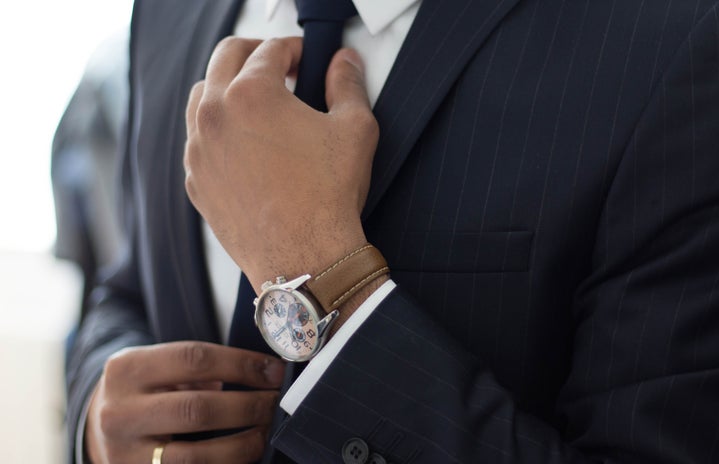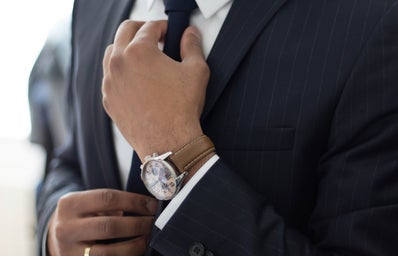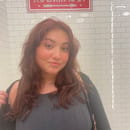With only a few years left until graduation and the time comes to embark on the real world, I find myself contemplating how I will showcase myself professionally. One thing that gets heavily thrown around, especially within my program of study, is the concept of a “branded identity.” How can we create a unique brand for ourselves, and what does it convey about us?
One point made by my internship counsellor that echoes in my mind with every resume or prospect email I send out is that employers will take, on average, only 30 seconds to glance at your application. And that first glance up-and-down at the beginning of an interview determines whether they want to consider you for the position.
While the three-hour-long lecture on self-branding felt like it would never end, it got me thinking. In a society obsessed with branding and social media making it so easy, is this something I need to consciously pay attention to at all times?
Coincidentally, in one of my fashion studies classes, we were analyzing the movie American Psycho. Prior to watching this movie in my Monday morning class, I lessened the story of this notorious serial killer to the cinematic bible for frat bros and aspiring future toxic male CEOs.
However, I never thought to view it with such a critical fashion lens. My professor, while discussing fashion facts regarding why some brands didn’t want to sign off on Christian Bale’s character sporting their clothes, kept describing their wardrobe with a phrase I’d never heard before. The word he used was “Yuppie.”
Yuppie, coined in the 1980s, was a redefining moment in not only fashion history but in American social culture as a whole. A term standing for young, urban professionals was a semi-derogatory way to describe the twenty-something, upper-class, Ivy grads that were seeking success and corporate excess within the hustle of the growing American economy.
While the creative industries aren’t quite a linear comparison to the ’80s brokers on Wall Street as a collective culture of the next generation entering the workforce, what does yuppie look like in the dawn of Gen-Z business professionals?
Being the modern ‘yuppie’
The actual aesthetic of the yuppie is definitely one that isn’t easy to pin down. With close ties to the old money aesthetic we have seen dominate TikTok over the last few years, yuppie at its core and, in its simplest terms, suits a “dress for success” mentality. But what does success actually look like in 2024?
Laura Jackson and Joy Montgomery write for Vogue, “Thanks to the pared-back stylings of brands such as The Row, Bottega Veneta, and Khaite, we have seen a return to a more low-key approach to luxury — ‘quiet luxury’ as some people are calling it, or non-trend trends. It’s less austere than minimalism but more polished than ‘normcore.’ It’s Sienna Miller in Anatomy of a Scandal meets off-duty Olsen twins; it’s a battered Hermès Kelly bag or a Max Mara investment coat thrown over an ancient pair of vintage jeans.”
Luxury and its relationship to success is a constant measurable degree that has existed within our culture. In today’s economic climate, where the class divide becomes greater and the cost of living is inconceivable, we look towards a tailored depiction of what wealth and success look like. The “rich person” narrative has historically been a methodology created by the seemingly want-to-be rich-looking crowd, and therefore, society’s interpretation of the subject is skewed towards that image.
This concept came to be as early as the Gilded Age — following the Industrial Revolution — which people believe to be the birth of the corresponding yuppie styles such as “Ivy” or “old money.” While abundant economic growth within America only made the rich get richer, the industry boom also saw the emergence of the social class labelled as the “nouveau riche.”
In order to obtain the cultural divide between the classes, the “old money” became partaking in and purchasing things that were financially out of reach, even amongst other members of the upper class, while simultaneously flaunting their level of wealth in a non-confrontational manner.
Amanda Null says in The Atlantic, “These terms describe a particular mode of dressing said to be favoured not by the rich, but by the genuinely, generationally wealthy — forget trust funds, think family foundations.”
A hilarious example of this concept is the HBO hit show Succession, launched in 2018. A specific scene went viral that perfectly encapsulates the fundamentals of this concept. The character Tom (Matthew Macfadyen), son-in-law of billionaire media tycoon Logan Roy (Brian Cox), makes a scoffing comment regarding the female date of another character and her ostentatious outfit worn to an upscale business affair.
The unnamed girlfriend is seen holding a medium-sized Burberry tote covered with the signature brand tartan, that originally retailed in real-life department stores for over $2,500. Tom refers to the bag as a “ludicrously capacious bag,” continuing, “What’s even in there? Flat shoes for the subway? Her lunch pail?”
This bag, along with so many other wardrobe decisions within the show, has been heavily discussed through countless online reviews and YouTube analyses. Youtuber Cassie Thorpe theorizes that this line implies that the girlfriend, in carrying a bag like this, is trying too hard to fit into rich society as she, by herself, wouldn’t be invited to be in the presence of such exclusive wealth regularly.
Her carrying a pair of flats is a slight to the fact that she may take public transit rather than have a driver. Bringing her own lunch from home means she doesn’t have an assistant to go grab takeaway from her preferred lunch spot.
The presence of the bag itself — to high society — speaks not only to what they deem to be fashionable but rather what they deem is the difference between their level of class and what the “wannabes” of society try to project. The “old money” aesthetic erases the concept of high end versus low end because the attitude toward designer items should be “so passé.” Your luxury pieces should just fly under the radar, where those in the know will know how much they cost.
Circling back to the example of American Psycho, Bateman makes numerous references to the specific luxury brands that he or his equally ostentatious colleagues are wearing; however, in no way does the external appearance of them indicate where they are from… because money talks but wealth whispers.
On this topic, Eva Wiseman writes, “‘Stealth wealth’ is the name given to the clothes worn by the extremely rich– very fine wools in navy or grey, oversized coats, tiny handbags, whites so bright they’re almost blue, a thousand shades of camel, a whole caravan of them, a palette that whispers ‘taste’ with a little lisp. Logos are replaced with secret codes — a clever little stitch at the hem or a hoodie made of cashmere.”
A yuppie will always have their fitted dress shirt ironed, a belt matching their shoes and pants tailored to the appropriate length, while simultaneously taking the subway to work. Everything tends to be within the same neutral colour palette with fairly basic garment patterns, nothing too flashy, no rips, no logos. Where your clothing is offensively expensive yet offensively dull; however, exude the impression of wealth, as the name of the game is definitely “fake it until you make it!” Making it, in this context, refers to making it to the salary that can further afford this wardrobe without a suffering bank account.
The Atlantic article continues, “All of a sudden, more accessible stores such as H&M and Zara, are selling nondescript, generously cut trousers and oversize button-downs and double-breasted blazers and grandpa loafers. The fashion website Hypebeast cites, by its count, 1.4 billion views for stealth wealth meaning on TikTok as evident that the kids really are dying to save up and swathe themselves in cashmere — or, more likely, to buy budget-friendly knit blends.”
The TikTok-ifaction of Branding
I do think that Gen-Z can exist in both places. While we are obsessed with a culture of generating success, more out of necessity than desire, we are equally as obsessed with literally branding ourselves in fashion trends. The most common example in today’s day and age is the TikTok fit checks I see all over my FYP. And no one has been doing this trend better or attracting more headlines than Pookie.
If you haven’t scrolled through TikTok for the past couple of months or have somehow managed to avoid them altogether, the controversial couple Campbell Puckett and husband Jett Puckett have been gaining virality with their 30-second fit check videos where Jett lists off the outfit and corresponding brand each item belongs to that “Pookie” (Campbell) is wearing. Making the phrase “Pookie is looking absolutely fire tonight” go absolutely viral.
While I have absolutely no idea what exactly Jett and ”Pookie” did prior to social media, their accelerated success has only grown their closet and the budget of their fit checks as I have yet to see one video that doesn’t list off multiple high-end designer brands.
From the virtual appearance of this couple’s lifestyle and clothing choices, they exude the same level of refinery and class as a yuppie without absurd flashiness, where we would know (or assume) they are wealthy because of the brands.
My current writing fit check:
- Top: Aritzia sweatshirt (5 years old)
- Pants: Thrifted (with stretched waistband)
- Jacket: Brooklyn Flea Market (most likely once belonging to an 80-year-old man)
- Socks: Amazon (highly mismatching)
- Shoes: Sambas (surprisingly new)
I Don’t know if Pookie would approve…
Now, is all this one massive conclusion to say that I won’t be successful or get ahead in the world without looking a certain way? — no….well, possibly? Our spectrum of the modern workforce has expanded beyond previous generations’ wildest dreams and hopefully will continue to do so.
An employer will most definitely not ask to list top to bottom where your outfit is from. However, I do believe that there will always exist a culture in which we must lean into looking “right for the job” no matter what the job may be, translating into elements as materialistic as our clothing choices.
While I am clinging onto the years I have left in university, the unpredictability of the professional world is only something I will undoubtedly have to adapt to when the time comes. I better start curating my elevated closet now.


